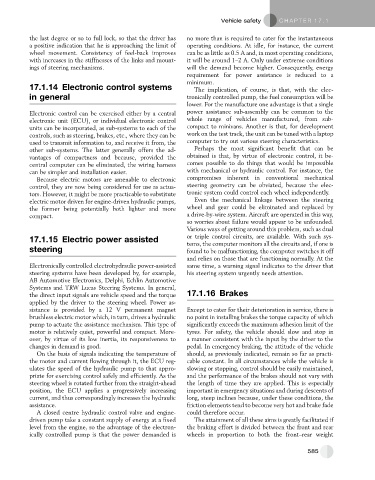Page 574 - Automotive Engineering Powertrain Chassis System and Vehicle Body
P. 574
Vehicle safety C HAPTER 17.1
the last degree or so to full lock, so that the driver has no more than is required to cater for the instantaneous
a positive indication that he is approaching the limit of operating conditions. At idle, for instance, the current
wheel movement. Consistency of feel-back improves can be as little as 0.5 A and, in most operating conditions,
with increases in the stiffnesses of the links and mount- it will be around 1–2 A. Only under extreme conditions
ings of steering mechanisms. will the demand become higher. Consequently, energy
requirement for power assistance is reduced to a
minimum.
17.1.14 Electronic control systems The implication, of course, is that, with the elec-
in general tronically controlled pump, the fuel consumption will be
lower. For the manufacture one advantage is that a single
Electronic control can be exercised either by a central power assistance sub-assembly can be common to the
electronic unit (ECU), or individual electronic control whole range of vehicles manufactured, from sub-
units can be incorporated, as sub-systems to each of the compact to minivans. Another is that, for development
controls, such as steering, brakes, etc., where they can be work on the test track, the unit can be tuned with a laptop
used to transmit information to, and receive it from, the computer to try out various steering characteristics.
other sub-systems. The latter generally offers the ad- Perhaps the most significant benefit that can be
vantages of compactness and because, provided the obtained is that, by virtue of electronic control, it be-
central computer can be eliminated, the wiring harness comes possible to do things that would be impossible
can be simpler and installation easier. with mechanical or hydraulic control. For instance, the
Because electric motors are amenable to electronic compromises inherent in conventional mechanical
control, they are now being considered for use as actua- steering geometry can be obviated, because the elec-
tors. However, it might be more practicable to substitute tronic system could control each wheel independently.
electric motor driven for engine-driven hydraulic pumps, Even the mechanical linkage between the steering
the former being potentially both lighter and more wheel and gear could be eliminated and replaced by
compact. a drive-by-wire system. Aircraft are operated in this way,
so worries about failure would appear to be unfounded.
Various ways of getting around this problem, such as dual
or triple control circuits, are available. With such sys-
17.1.15 Electric power assisted
tems, the computer monitors all the circuits and, if one is
steering found to be malfunctioning, the computer switches it off
and relies on those that are functioning normally. At the
Electronically controlled electrohydraulic power-assisted same time, a warning signal indicates to the driver that
steering systems have been developed by, for example, his steering system urgently needs attention.
AB Automotive Electronics, Delphi, Echlin Automotive
Systems and TRW Lucas Steering Systems. In general,
the direct input signals are vehicle speed and the torque 17.1.16 Brakes
applied by the driver to the steering wheel. Power as-
sistance is provided by a 12 V permanent magnet Except to cater for their deterioration in service, there is
brushless electric motor which, in turn, drives a hydraulic no point in installing brakes the torque capacity of which
pump to actuate the assistance mechanism. This type of significantly exceeds the maximum adhesion limit of the
motor is relatively quiet, powerful and compact. More- tyres. For safety, the vehicle should slow and stop in
over, by virtue of its low inertia, its responsiveness to a manner consistent with the input by the driver to the
changes in demand is good. pedal. In emergency braking, the attitude of the vehicle
On the basis of signals indicating the temperature of should, as previously indicated, remain so far as practi-
the motor and current flowing through it, the ECU reg- cable constant. In all circumstances while the vehicle is
ulates the speed of the hydraulic pump to that appro- slowing or stopping, control should be easily maintained,
priate for exercising control safely and efficiently. As the and the performance of the brakes should not vary with
steering wheel is rotated further from the straight-ahead the length of time they are applied. This is especially
position, the ECU applies a progressively increasing important in emergency situations and during descents of
current, and thus correspondingly increases the hydraulic long, steep inclines because, under these conditions, the
assistance. friction elements tend to become very hot and brake fade
A closed centre hydraulic control valve and engine- could therefore occur.
driven pump take a constant supply of energy at a fixed The attainment of all these aims is greatly facilitated if
level from the engine, so the advantage of the electron- the braking effort is divided between the front and rear
ically controlled pump is that the power demanded is wheels in proportion to both the front–rear weight
585

